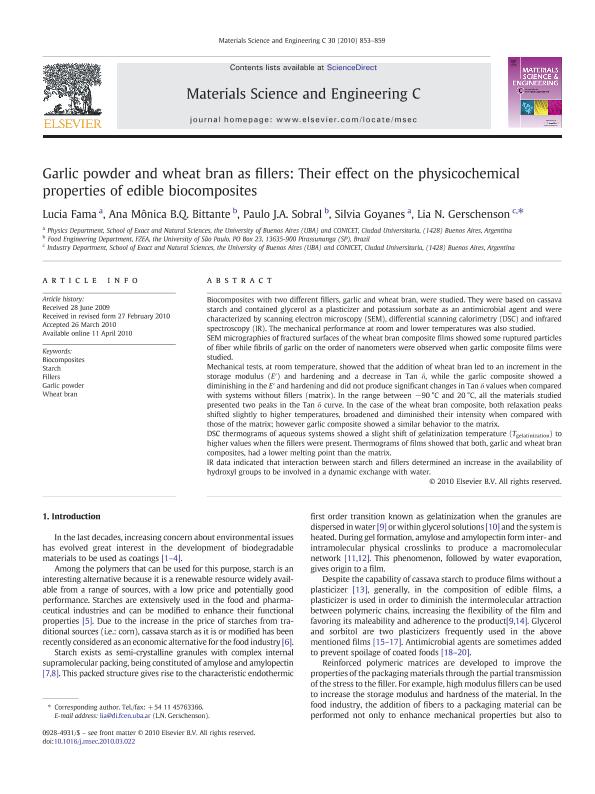Mostrar el registro sencillo del ítem
dc.contributor.author
Fama, Lucia Mercedes

dc.contributor.author
Bittante, Ana Mônica B. Q.
dc.contributor.author
Sobral, Paulo J. A.
dc.contributor.author
Goyanes, Silvia Nair

dc.contributor.author
Gerschenson, Lia Noemi

dc.date.available
2018-09-11T19:19:09Z
dc.date.issued
2010-07
dc.identifier.citation
Fama, Lucia Mercedes; Bittante, Ana Mônica B. Q.; Sobral, Paulo J. A.; Goyanes, Silvia Nair; Gerschenson, Lia Noemi; Garlic powder and wheat bran as fillers: Their effect on the physicochemical properties of edible biocomposites; Elsevier Science; Materials Science and Engineering: C; 30; 6; 7-2010; 853-859
dc.identifier.issn
0928-4931
dc.identifier.uri
http://hdl.handle.net/11336/59158
dc.description.abstract
Biocomposites with two different fillers, garlic and wheat bran, were studied. They were based on cassava starch and contained glycerol as a plasticizer and potassium sorbate as an antimicrobial agent and were characterized by scanning electron microscopy (SEM), differential scanning calorimetry (DSC) and infrared spectroscopy (IR). The mechanical performance at room and lower temperatures was also studied. SEM micrographies of fractured surfaces of the wheat bran composite films showed some ruptured particles of fiber while fibrils of garlic on the order of nanometers were observed when garlic composite films were studied. Mechanical tests, at room temperature, showed that the addition of wheat bran led to an increment in the storage modulus (E′) and hardening and a decrease in Tan δ, while the garlic composite showed a diminishing in the E′ and hardening and did not produce significant changes in Tan δ values when compared with systems without fillers (matrix). In the range between -90 °C and 20 °C, all the materials studied presented two peaks in the Tan δ curve. In the case of the wheat bran composite, both relaxation peaks shifted slightly to higher temperatures, broadened and diminished their intensity when compared with those of the matrix; however garlic composite showed a similar behavior to the matrix. DSC thermograms of aqueous systems showed a slight shift of gelatinization temperature (Tgelatinization) to higher values when the fillers were present. Thermograms of films showed that both, garlic and wheat bran composites, had a lower melting point than the matrix. IR data indicated that interaction between starch and fillers determined an increase in the availability of hydroxyl groups to be involved in a dynamic exchange with water.
dc.format
application/pdf
dc.language.iso
eng
dc.publisher
Elsevier Science

dc.rights
info:eu-repo/semantics/openAccess
dc.rights.uri
https://creativecommons.org/licenses/by-nc-nd/2.5/ar/
dc.subject
Biocomposites
dc.subject
Fillers
dc.subject
Garlic Powder
dc.subject
Starch
dc.subject
Wheat Bran
dc.subject.classification
Ingeniería de los Materiales

dc.subject.classification
Ingeniería de los Materiales

dc.subject.classification
INGENIERÍAS Y TECNOLOGÍAS

dc.title
Garlic powder and wheat bran as fillers: Their effect on the physicochemical properties of edible biocomposites
dc.type
info:eu-repo/semantics/article
dc.type
info:ar-repo/semantics/artículo
dc.type
info:eu-repo/semantics/publishedVersion
dc.date.updated
2018-09-10T16:46:57Z
dc.journal.volume
30
dc.journal.number
6
dc.journal.pagination
853-859
dc.journal.pais
Países Bajos

dc.journal.ciudad
Amsterdam
dc.description.fil
Fil: Fama, Lucia Mercedes. Universidad de Buenos Aires. Facultad de Ciencias Exactas y Naturales. Departamento de Física; Argentina. Consejo Nacional de Investigaciones Científicas y Técnicas; Argentina
dc.description.fil
Fil: Bittante, Ana Mônica B. Q.. Universidade de Sao Paulo; Brasil
dc.description.fil
Fil: Sobral, Paulo J. A.. Universidade de Sao Paulo; Brasil
dc.description.fil
Fil: Goyanes, Silvia Nair. Universidad de Buenos Aires. Facultad de Ciencias Exactas y Naturales. Departamento de Física; Argentina. Consejo Nacional de Investigaciones Científicas y Técnicas; Argentina
dc.description.fil
Fil: Gerschenson, Lia Noemi. Universidad de Buenos Aires. Facultad de Ciencias Exactas y Naturales. Departamento de Industrias; Argentina. Consejo Nacional de Investigaciones Científicas y Técnicas; Argentina
dc.journal.title
Materials Science and Engineering: C

dc.relation.alternativeid
info:eu-repo/semantics/altIdentifier/doi/http://dx.doi.org/10.1016/j.msec.2010.03.022
dc.relation.alternativeid
info:eu-repo/semantics/altIdentifier/url/https://www.sciencedirect.com/science/article/pii/S0928493110000822
Archivos asociados
